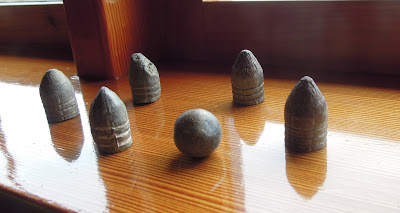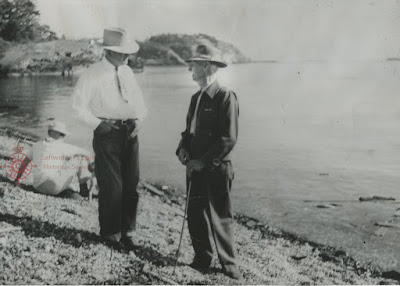"Rabbit hunters from the mainland who visit San Juan Island had been making a shambles of the monuments at historic American Camp, relic of the 'Pig War' days of the 1800s when American and British troops jointly occupied the island.
The three monuments in the park were pock-marked and chipped and the inscription plates had been bruised by bullets.
San Juan County authorities did not like what had happened to their landmark, but the site was where the 'wild' rabbits congregated in greatest numbers.
William Rosler of Friday Harbor, son of Christopher Rosler, one of Capt. George Pickett's soldiers who helped build American Camp, remembered when there were no rabbits to shoot on San Juan.
 |
| William Rosler, age 81 years. son of Christopher Rosler, a soldier at American Camp, San Juan Island, WA. Photo dated 1960. Original photo from S.P.H.S.© |
'We used to hunt 'coon when I was a boy,' Rosler said.
Rosler is the only first-generation descendant of the 'Pig War' soldiers in the islands. His father, who died in 1907, was the last survivor of the original garrison. His mother died two years later.
Rosler, at 81, has a keen memory.
'My father was a subject of the Duke of Hesse until he changed his citizenship. See, that's what it says on this paper.'
Rosler displayed a declaration of intention to become an American citizen, sworn to at Port Townsend in Feb 1861, by his father.
'Dad came to the US from Germany as cabin boy on a ship when he was 14. He worked for an uncle who was a shoemaker in New York. Dad wanted to go west to the gold fields and the only way he knew to do it without money was to enlist. Instead of stopping in California, the troops were sent to Steilacoom. Dad got shot in the arm during an Indian-war skirmish. He was shipped to Fort Bellingham under Captain Pickett and from there to San Juan.
'After five years in the service, Dad was discharged from Company D, 9th Infantry, on the island. He took a soldier's homestead close to the camp. The first work he did was to haul wood for the fort. He kept on doing it until the troops left in 1873.
B.C. Gillette owned the right to the adjoining homestead at American Camp and my father bought his preemption.'
Rosler has the two patents among his papers, one dated 1873 and the other ten years later.
The original log house on the homestead burned and was replaced with a frame one.
Bill's mother was an Indian, born at Fort Simpson, BC, in 1846. Her family moved to Griffin Bay, north of the military post in 1861, and she was married to Rosler a year later, while he still was in the Army.
Her people had a village––at least 20 families––not far from my father's homestead,' Bill Rosler recalled.
When I was a kid most of American Camp was standing. I used to play in the old buildings.'
Some of the elder Roslers' house furnishings were obtained from the camp when it was discontinued.
Rosler told how certain geographical points on the island got their names. He said as a child he used to pick up spent bullets on Bald Hill, where soldiers held target practice.
The soldiers stopped on these expeditions at a little island in Griffin Bay and ate their lunch. Ever after it was called Dinner Island.
Chicken Rock, near Cattle Point, Rosler recalled, was named because of the wreck of a small boat with a load of chickens.
'Fish Creek, once was called God's Pocket. It was where smugglers hid. Nobody seems to remember that Pear Point was formerly Barrel Point, because of a barrel found there. North Star Rock, also near Griffin Bay, got its name from a boat carrying cattle that was wrecked on it. The animals drowned and floated ashore. Father said he helped to skin them.'
As part of his duties, the elder Rosler cared for the horses at American Camp. One time he went out to the pasture, wolves took after him. In the early period of the island settlement, many wolves were seen and hunting had a more serious aspect than in modern times.
Rosler remembers when in summer months Indians camped on the coves and there was a big 'rancheree' at Kanaka Bay in fishing season and another large camp of British Columbia Indians at Deadman's Bay.
'They came to dry fish and clams and get ready for winter.' Rosler said. 'They used everything they caught. They had to work for it wasn't like playing at hunting rabbits.'"
The above text from The Seattle Times 20 Nov. 1960.
1887: American Camp Color.
"Some thirty of the garrison at the American Camp on San Juan Island have been on the search for the last four days for a notorious character, who formerly dabbled in quartz in Victoria. If Captain Gray finds the "Doc", a ball and chain will grace his 'comely' person for at least one calendar month. He is charged with killing other people's cattle, and using the proceeds for his own benefit."Puget Sound Gazette. April 1867
















